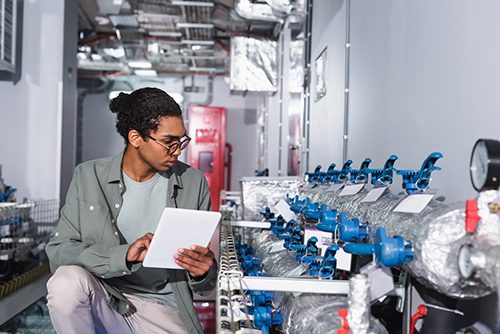Part 1 of this series discussed key factors for mitigating excessive water usage at data centers. Energy management is another area of focus for these facilities, specifically when it comes to heat exchange.
Data centers use an estimated 2% of power in the US, but there has not been an ideal model for assessing energy efficiency because of rapidly evolving data center designs. Rack densities in modern data facilities can range from 40 to 500 W/ft2 and result in uneven heat load, making typical commercial building energy modeling a poor fit. Furthermore, IT equipment, cooling, and HVAC equipment are not always evolving at the same rate.
Operators measure power usage effectiveness (PUE) as one way to control energy consumption at their facilities.
The Threat of Biofilm to Heat Exchange Efficiency
Operators can sometimes overlook the impact that improper water treatment can have on energy consumption. Microbiological fouling in water-side heat exchange and chilled water systems can be the culprit that makes or breaks a site’s PUE and sustainability targets.
On water-side heat exchange surfaces, fouling will not only result in much higher energy consumption because of poor heat exchange efficiency, but often shorten the lifespan of the heat exchange equipment itself.
Microbiological fouling can also be a huge issue in chilled water systems, especially when large thermal storage tanks are used. Proper microbiological control is often overlooked in this area because the chilled water is thought of as a “closed” system. However, the low flow in the tank creates an area ripe for sediment to settle, promoting bacteria and biofilm growth.
The High Costs of Inefficient Heat Exchange
When biofilm spreads and establishes itself on heat exchange surfaces, it will significantly inhibit heat exchange efficiency. Whereas the thermal conductivity of copper, aluminum, and stainless steel are 384.0, 138.5, and 16.3 W/mK respectively, the thermal conductivity of biofilm averages 0.65 W/mK1. A biofilm layer reducing tube diameter by 10% would reduce heat exchange by 55%.
In the language of operating costs, a 0.6mm-thick layer of biofilm on heat exchange surfaces of a 500-ton chiller would cost an additional $15,000 per year to operate.
Premature and unexpected equipment failure can be a threat to uptime and data center reliability. Chiller tube lifespan is drastically reduced by persistent microbiological issues. Taking the equipment off-line for retubing or replacement is neither cheap nor ideal for preserving redundancy. The same 500-ton chiller would cost nearly $125,000 to retube or $350,000 to fully replace.
A Little Prevention Goes a Long Way
Generation 5 data centers are steadily moving away from traditional chiller plant cooling systems, opting instead for more modular solutions designed to be more water- and energy-friendly.
These new generation cooling strategies still rely heavily on water for cooling and are not without their treatment challenges. Microbes still proliferate in these systems, and proper water pretreatment or preventative programs are necessary to preserve equipment life. Failing to implement an appropriate treatment strategy can lead to health hazards via waterborne pathogens and unnecessary early cooling media replacement. A little preventative maintenance can go a long way in new generation cooling systems.
Contact ChemTreat today for a consultation on preventative maintenance in your cooling systems. Our team has experience helping data center customers solve their water treatment challenges.
Always remember that all systems are different, and due diligent is necessary to determine the feasibility for utilizing these methods. Consult your equipment manuals and guides.
Free Sustainability Report
Want to know where you can make the most impact in improving PUE? ChemTreat is offering a free sustainability assessment and report to help you identify where and how you’re using water and power. We can also offer key recommendations to help you achieve your water and energy savings goals. Click the link below to claim your free report!

Citations:
1. Sun, K., Lui, N., Lui, X., Hong, T., “Prototype Energy Models for Data Centers”, Building Technology and Urban Systems Division Lawrence Berkeley National Laboratory, Jan 2021.
2. Biofouling: https://doi.org/10.1002/bit.260230902
3. EPRI- 2015 Cooling Tower Seminar
4. Crocker, Michael. Chiller Efficiency: A Calculator for Estimating the Cost of Condenser Fouling. http://innovastechnologies.com/chiller-efficiency-calculator-for-estimating-condenser-fouling-costs/
Cost estimate based on a 500-ton chiller with 3,000 annual operational hours and a $0.09/kWhr cost of electricity.
Additional Sources
1. Heslin, Kevin. Corporate Sustainability Seems Elusive: How Can It Help? https://www.7x24exchange.org/corporate-sustainability-seems-elusive-how-can-it-help/
2. Alliance to Save Energy, Incorporated, ICF, Incorporated, ERG, U.S. Environmental Protection Agency, Brown, Richard E, Brown, Richard, Masanet, Eric, Nordman, Bruce, Tschudi, Bill, Shehabi, Arman, Stanley, John, Koomey, Jonathan, Sartor, Dale, Chan, Peter, Loper, Joe, Capana, Steve, Hedman, Bruce, Duff, Rebecca, Haines, Evan, Sass, Danielle, & Fanara, Andrew. Report to Congress on Server and Data Center Energy Efficiency: Public Law 109-431. United States. https://doi.org/10.2172/929723


